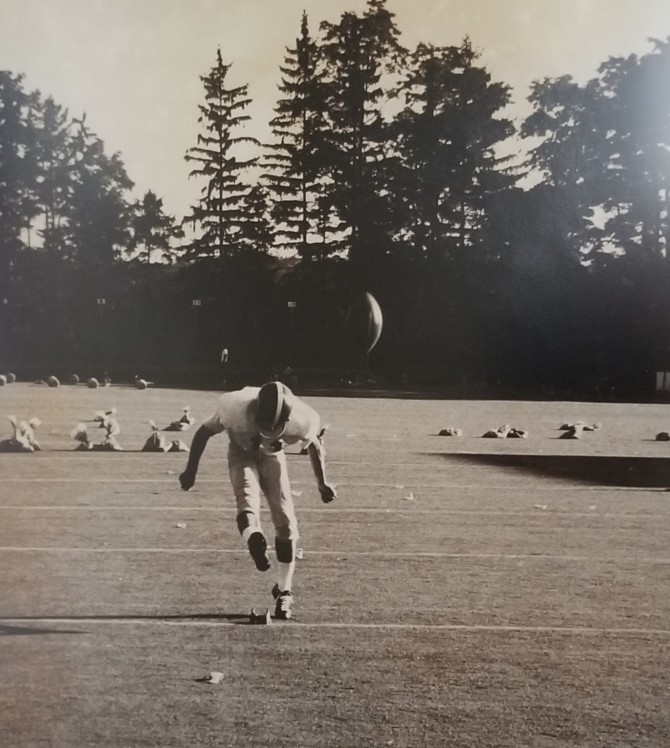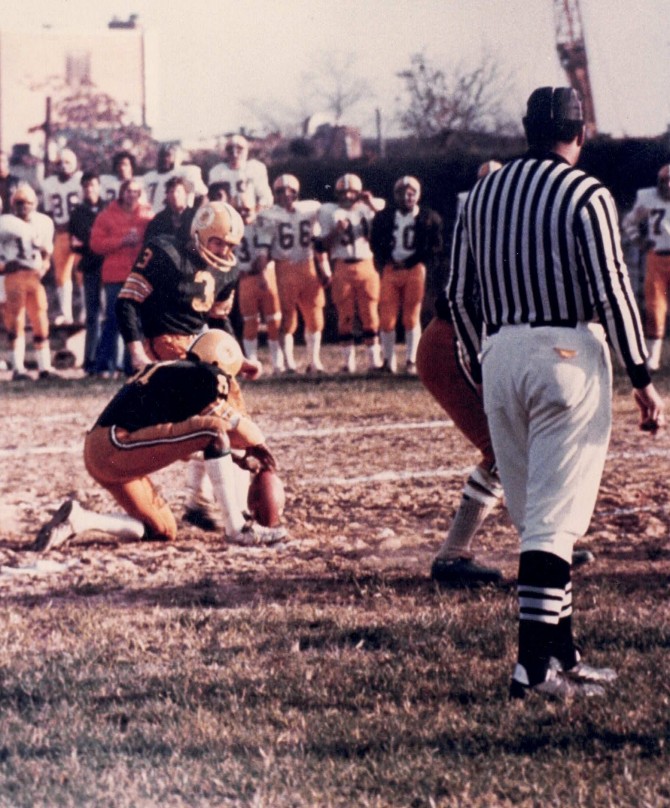NFL uses kicking tee invented by Cornell alum
The 2022-23 regular season National Football League schedule kicks off Thursday, Sept. 8, with the defending Super Bowl champion Los Angeles Rams hosting the Buffalo Bills. No matter which team kicks off, the tee they will use to hold the ball steady and elevate it off the turf will be one invented by H. Jay Spiegel ’74.
In fact, every opening kickoff of every NFL game since the 1999-2000 season has been made off of one of Spiegel’s patented Ground Zero 1 tees, according to Spiegel.
It should come as no surprise that Spiegel chose to attend Cornell because, of the five colleges he was accepted to, he felt he had the best football opportunity at Cornell. He made the team as a second-string kicker in his first year but left the team before the season began. After that, he decided to play intramural and Sprint football in the following years at Cornell.
But football, and especially kicking a football, continued to hold Spiegel’s attention – even as he charted a path to a non-football career.
Spiegel created his own major at Cornell, taking advantage of something called the College Program. A similar option still exists, though now it is called the Independent Major. He called his degree program Energy Conversion and it allowed him to take classes in electrical, mechanical, nuclear and environmental engineering. Long before graduating, Spiegel knew he wanted to become a patent attorney and this particular constellation of classes positioned him well for the future.
After graduating from Cornell in 1974, Spiegel worked at the U.S. Patent and Trademark Office until 1982 as an assistant examiner and then as a primary examiner. He also earned his law degree from George Mason University in 1981. Since 1982 he has been in private practice, specializing in patent, trademark and copyright law.
Through those years at the patent office, Spiegel was prevented from applying for any patents himself by government policy. Once he was no longer a government employee, he had to wait one year. But all that time his brain was churning away, working on ideas for a kicking tee that would better fit the style of the newest generation of NFL kickers.
While in high school he had written to recently-retired NFL star Lou Groza to see if Groza would give him kicking pointers. Much to his surprise, Groza, who lived in the Cleveland area, wrote back. The two met to work on technique and became lifelong friends. Spiegel, who was a member of the Cornell Glee Club, even sang at Groza’s memorial service when Groza passed away in 2000.
Spiegel himself kicked in the traditional straightaway style popular at the time. But his high school days in Cleveland coincided with the introduction of soccer-style kicking to professional football by Pete Gogolak ‘64, who had been a kicker on the Big Red football team. By the time Spiegel was ready and able to apply for patents, many NFL kickers were kicking soccer-style and the existing tees were not ideal. They had two prongs that stuck up to hold the ball upright and these soccer-style kickers were making contact with the prongs before the ball, adversely affecting their kicks.
Spiegel designed a tee without prongs and applied for a patent in 1983. By 1985 he convinced some NFL kickers to try out his prototype and give him feedback. He continued to improve his design and by 1995 the National Football League approved his tee for use in games. By the 2000-01 regular season all the teams had adopted Spiegel’s Ground Zero 1 tee, even though there were actually two other competing tee designs that were approved and available to them.
Spiegel started Premium Products, Inc., in 1985 to market the Ground Zero 1 and four of his other tee designs. In 2015 he sold the football tee portion of his business to Champion Sports.
Spiegel started his law practice, H. Jay Spiegel & Associates, in 1981 and has been practicing patent, trademark and copyright law with great success for 40 years. In that time, he has also received 45 patents of his own, with several making it to market. It becomes clear while listening to Spiegel talk that his tee holds a special place in his heart.
“When you’re a patent lawyer, you have to be honest with your clients and tell them that, typically, just 1% of patented inventions make back enough money to even pay for the cost of getting the patent,” Spiegel said. “Inventors all think that they will be one of the 1%. I have been very lucky and have gotten a lot of satisfaction and enjoyment from my inventions.”
If you tune in to Thursday night’s Bill-Rams game, make sure you are settled before the opening kickoff and then direct your attention to that often-overlooked piece of equipment sitting there on the 35-yard line. It’s a pretty good bet Spiegel will be doing the very same thing.



